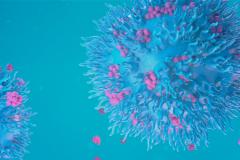Crohn’s disease and ulcerative colitis are gastrointestinal autoimmune diseases that can make it difficult for children to enjoy everyday activities and absorb the nutrients they need to grow. The researchers in Dr. Bruce Vallance’s lab at BC Children’s Hospital are dedicated to understanding why these debilitating diseases occur and how they can be treated. Shauna Crowley, a PhD student in the Vallance Lab, talks about how her research on the microscopic world inside our guts could lead to new treatments for these painful, lifelong conditions.
What are you researching right now?
I study how a common bacteria called Salmonella Typhimurium interacts with the intestine and causes disease. You may have heard of Salmonella in news stories about outbreaks of foodborne illness – eating food contaminated with this bacterium can cause diarrhea, abdominal cramping, fever and vomiting. In children, the elderly and people with compromised immune systems, Salmonella infection can require hospitalization and even be fatal.
I try to understand how our immune systems react to Salmonella by studying the inflammasome, which are groups of proteins that trigger an immune response. I look at how the cells lining the intestine use inflammasomes to protect themselves from Salmonella and what happens when these barriers fail.
Understanding how Salmonella gets past the body’s defenses may help us develop new therapies to treat foodborne illness.
My research could also shed light on how diseases like Crohn’s and colitis develop. These conditions occur when the immune system attacks helpful bacteria and healthy tissue in the gastrointestinal tract, causing symptoms including abdominal pain, fatigue, diarrhea and loss of appetite.
Based on previous research we’ve done in the Vallance Lab, we think there are similarities between how Salmonella breaks down our intestinal barrier and the harmful immune reaction seen in Crohn’s and colitis. Understanding these immune responses could help us develop new treatments. Right now, children with inflammatory bowel diseases take drugs, such as steroids or a class of medications called biologics that suppress their entire immune systems, which make them more vulnerable to infections and cancers. Moreover, as people take biologics, they often become less effective. This is particularly problematic for kids who will need to be on medication for the rest of their lives.
If we could target the specific immune reactions that cause Crohn’s and colitis, we could provide a long-term, effective treatment for these diseases without causing harmful side effects.
What do you like most about working at BC Children’s Hospital Research Institute?
As a scientist who doesn’t work directly with patients, I really appreciate the connection between clinical care and research at BC Children’s Hospital Research Institute. In the Vallance Lab, we work in close collaboration with Dr. Kevan Jacobson, the Division Head, Senior Clinician Scientist and Director of the pediatric gastroenterology program at BC Children’s hospital. He helps us put our experiments into the context of what he’s doing at the clinic, so clinical care informs research and vice versa. It’s rare to have this level of clinical impact in a basic science lab.
What’s one thing about your research you’d like to share with the public?
One of the coolest things about the microbiology of the gut is the diversity of microbes we all have living inside us. I think people are becoming more aware of the important role gut bacteria plays in health, but people may not realize that the bacteria in your intestine are incredibly unique from one another.
Think about the city of Vancouver and the diversity we have here with people coming from all over the world – the population of bacterial cells living inside your intestine is just as varied.
Increasingly with the help of new technologies, we’re able to zoom in and look at the genetic diversity of bacteria. This is really cool, because it may help us understand why certain people are more susceptible to illness. For example, when a large batch of food is contaminated with harmful bacteria, hundreds may eat it, but only a handful will get sick. What’s different about the people who get sick? The answer may lie in the genetics of their gut bacteria.
What do you like to do outside of work?
I really like to do crafts and have a creative outlet. I make furniture, sew, knit and crochet. One of my best friends who I’ve been sewing with for years has decided she loves sewing so much she’s going to go to fashion school, so now I get to go to fashion school vicariously through her. I’m pretty excited about that.




